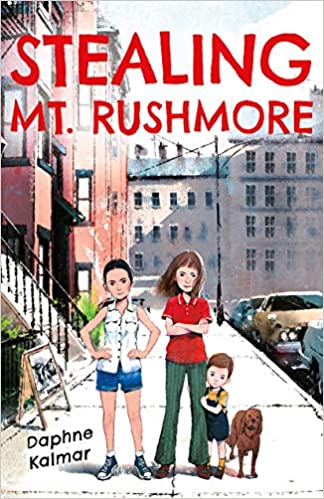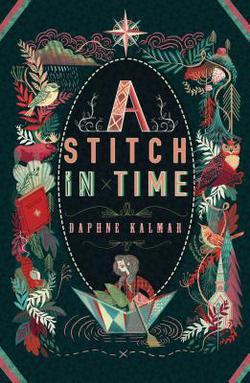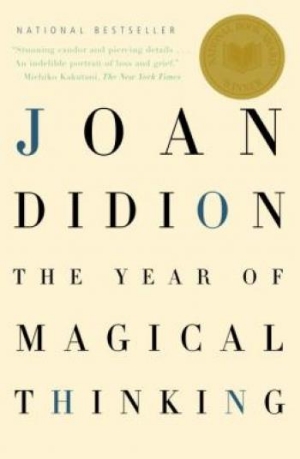
Stealing Mt. Rushmore comes out this coming Tuesday, August 18, and I’m pleased as punch to feature an interview with author Daphne Kalmar here today. Set during the social and political upheaval of the 1970s, the book is a Junior Library Guild selection (the gold standard for school libraries)!
Head’s up: Galaxy Bookshop is doing a virtual LIVE launch party on August 18, 2020, at 7:00 PM. Be sure to pre-register in advance to get the Zoom link. The pre-reg deadline is Monday, Aug. 17, at 6:00 PM. You can find registration details here.
At the launch party, Daphne will be giving away a copy of Stealing Mt. Rushmore, and hey—I’m giving away a copy, too! Hop to the end of this post and enter to win two books: Daphne’s two middle-grade novels—Stealing Mt. Rushmore and A Stitch in Time, both published by Feiwel and Friends at Macmillan. Then come back up the page to enjoy the interview and hear what Daphne has to say about crafting these gems. Deadline to enter my #Giveaway: Tuesday, August 25, 2020, at 11:59 PM.
A. B. Westrick: Daphne, welcome to my blog! I enjoyed meeting you at Vermont College of Fine Arts and have loved catching up with you online. It’s great to stay connected.
Daphne Kalmar: Thanks for tracking me down!
ABW: Let’s start with your first novel. I read A Stitch in Time two years ago (when it came out), and can still remember the characters well. Your eleven year-old protagonist, Donut, stuffs dead animals (especially mice), and that means, of course, that we have to talk about… taxidermy! This topic in a middle grade novel must be a first. Why’d you decide to make taxidermy (of all things) your protagonist’s hobby? How much research did you have to do to get the details right?

DK: Taxidermy slipped into the story during the free write where Donut appeared. I don’t know where it came from!
As it turned out, A Stitch in Time became a grief narrative and 11-year-old Donut is trying to work out what death means. Taxidermy is an attempt to make the dead as lifelike as possible. The artistry can be extraordinary and requires the taxidermist to pay close attention to the living animal in order to resurrect a dead one.
In a way our memories resurrect those who have died. Donut wants her pops back—she is sad beyond measure yet has no one to hold her and allow her to safely express that sadness. If she moves forward she feels she will lose her pops so she resists change at all costs. When she examines her friend Sam’s flock of taxidermied birds, she imagines they could fly off the shelves in a great flapping joyful moment. Her pops just might walk through the door. Her loss is too painful to face head on and her thoughts about the birds and dead mice are her way of processing her grief.
ABW: As a reader, my heart aches for her. Donut is orphaned shortly before the story begins, and in the same way that her stuffed mice’s glass eyeballs seem to give them new life, so riding in her dad’s “folding boat” seems to bring Dad back to life. Not in the flesh, of course. But I think it’s accurate to say that in this story, you’ve crafted a deep sense of connectedness between life and death. Could you tell us a bit about your interest in writing this book? What was your starting point for writing A Stitch in Time?
DK: In the early stages of grief many of us experience what Joan Didion called “magical thinking.” I didn’t consciously imbue objects in the story with magic but they appeared, as often happens in a rough draft.
Donut has filled her dad’s invention, the folding boat, with magical powers—it is fragile and unstable on the water yet she insists it will make it across Dog Pond in rough water. The boat she names Nehi is a totem, a magical object that holds her dad close and keeps her safe. She escapes from her Aunt Agnes in the Nehi to Chanticleer, the cabin in the woods. And as long as the Nehi is close by, she can imagine her pops is close by. She can steer clear of the deep spot in Dog Pond, the dark unknown, and the crushing reality that her dad is gone forever.
ABW: I just want to hug her.
Now tell me what drew you to the story in Stealing Mt. Rushmore. This protagonist (Nellie) is two years older than Donut and is also grieving a loss, but it’s not a death. It’s that Mom has abandoned the family. You write sadness really well. When you sit down to craft a scene, how do you get yourself into the emotional head-space that you need to write about loss and the complexity of emotions surrounding it?

DK: I experienced loss as a child and a teenager, and I can draw on the memories of that time, yet each of my characters has to come at their pain in their own way. Their journeys are different from mine. It’s the voices of my characters that carry me through their emotional arcs.
Donut responded to loss with anger at the world. She kicked rocks and told adults off. I’ve had some adult readers perceive Donut as a thankless brat (I suspect that if Donut was a male character her anger would not have been seen in a negative way). But I think kids need to read about righteously angry girls.
ABW: Agreed. Very good point. But that’s a whole other conversation, isn’t it? Maybe another time!
DK: Yes. Good—another time! Now as for Nellie’s grief—it emerges in a way that’s different from Donut’s. Nellie vacillates between her rage at her mother who has abandoned her to a deep yearning to have her back. This is echoed in her 13-year-old seesaws between her love of hopscotch and desire to be a 10 year-old again to insisting on her own agency in her dysfunctional home where she begins to take a stand.
ABW: You wrote Donut’s story in close-third person from her point of view and Nellie’s story in first-person, and I wondered if you found one approach easier than the other. Or different? Why did you decide to write Nellie’s story in first person, rather than close-third?
DK: It’s all about voice. In early drafts I tried out first person point of view and close third point of view in both novels. It became immediately obvious to me which one worked. In Stitch Donut’s voice went flat in first person. Paradoxically, I needed a wider lens—psychic distance—to get closer to her pain.

For Nellie I tried out third person point of view and lost the voice entirely. Nellie is two years older than Donut and she’s finding her voice, growing apart from the adults in her life. First person point of view was the only choice. But I think experimenting with POV is helpful. When I see a character fade away in the wrong POV, it allows me to get to know them better.
ABW: I love that. I’ve always been fascinated by the concept of voice and how it works (or doesn’t) on the page.
Now I want to mention the way you talk about certain moments. Some of your descriptions are priceless! For example, in A Stitch in Time when we meet Marcel, the back-woods trapper who owns ferocious dogs and breaks the law, Donut notes that he “never seemed to be in need of the back and forth that made up a conversation.” I love that line. It’s just so genuine-feeling. And I’m wondering how you craft your characters. Are they based on someone you know? Or do you make them up totally from scratch?

DK: I have made friends with many older Vermonters since I moved here 18 years ago. Their voices are in my head along with the voices of a wide range of people I’ve known in the six states where I’ve lived. Marcel is an amalgam of many Vermonters I’ve gotten to know.
The four kids in Nellie’s family are similarly an amalgam of the hundreds of students I’ve known during 20 years of teaching. When I’ve got a character on the page who comes out with some good lines, I think it’s because I know them so well. If I used one specific person as a model for a character, I would have trouble keeping he/she/them real on the page while imagining that the actual person is lurking in the ether, critiquing my portrait of them.
ABW: Hahaha. Yeah, that kind of critic isn’t helpful.
Now, can I ask you about bears? In A Stitch in Time, you have some wonderful scenes deep in the Vermont wilderness, and I especially love the part about a bear calling across the water to another bear. On your website, you include pictures of your writing shed in the woods, and I wondered if you have personal experience with bears. Do they roam through your woods? Tell me a bear story!
DK: Bears have smashed up my birdfeeders and I have heard bear stories from neighbors, heard their hoots in the woods, and found bear tracks and scat on my walks, but I’ve never seen a bear in the wild.
Years and years ago I read an article in The New Yorker about bears eating campers in tents. This image of “tent tacos” has never left me and I have a healthy respect for these powerful omnivores. Unwisely, Donut leaves an apple for “her” bear down by the water’s edge and she stands at the window that night, in the moonlight, and watches him eat it. A friend, Alton, read my book and asked me how I knew how a bear ate an apple. I clutched thinking I’d gotten it wrong (I wrote the scene without any clue how a bear would eat an apple). He said his friend was up in a tree stand hunting and described the bear below him eating wild apples and it was exactly how I’d written it. I can’t explain how happy this made me and relieved as well, that I’d gotten it right.
ABW: Oh, that’s great! Lovely serendipity.
Finally, I’d love to know a bit about you and how you get your writing done. What’s your writing process? Do you write in the mornings or late at night? Daily or in spurts? And what are you working on next?

DK: When I’m working on a project, I try to write every day in the morning. There’s a rhythm that develops and it’s much easier to immerse myself in the story if I haven’t been away from it very long. I know it’s going well when I can’t get to sleep because I’m thinking about my characters and thoughts about my story are filling up my day.
I am currently working on a middle grade fantasy I wrote at VCFA. It’s an insect road trip. Tanalai, a dragonfly, escapes from the Smithsonian Insect Zoo to find a true pond, the natural world where she belongs. She gets help from her traveling companions: Melli, a ditzy honey bee, and Mo, a wise guy housefly.
ABW: That sounds delightful! I look forward to seeing it in print. Thank you so much, Daphne, for taking the time to do this interview!
DK: My pleasure! Your questions were great and made me dig deep.
ABW: I very much appreciate your willingness to dig deep! I love meaty interviews.
Hey, readers: if you want to know more about Daphne and her books, you can find her online at her website, facebook, and twitter. If you visit, be sure to say so in the rafflecopter below! Each entry is a chance to win two books by Daphne. You can enter every day until the deadline: Tuesday, August 25, 2020, at 11:59 PM.


Congratulations on the new book! I love MG historical fiction and look forward to reading Stealing Mt. Rushmore!
Great covers! I experienced magical thinking after my Dad died. It’s so real! Congratulations on both novels.
Lyn, I love that you love MG historical fiction, and Barbara, thank you for your comment about magical thinking. I’m so glad you had a chance to read my interview with Daphne. I hope you get a chance to read both of her novels.
I probably should’ve mentioned that you learn a bit about Mt. Rushmore, too, which in a funny way seems timely these days because of a certain someone expressing interest in his own likeness getting added to the monument. (But the novel isn’t about any of that!)
Daphne I loved A Stitch in Time and look forward to reading your newest! I really enjoyed reading your thoughts on voice particularly. Anne, thanks for giving us another great interview!
I loved Daphne’s comments about voice, too. My question was point-of-view related and her answer came back all about voice, and it was great. Just great!